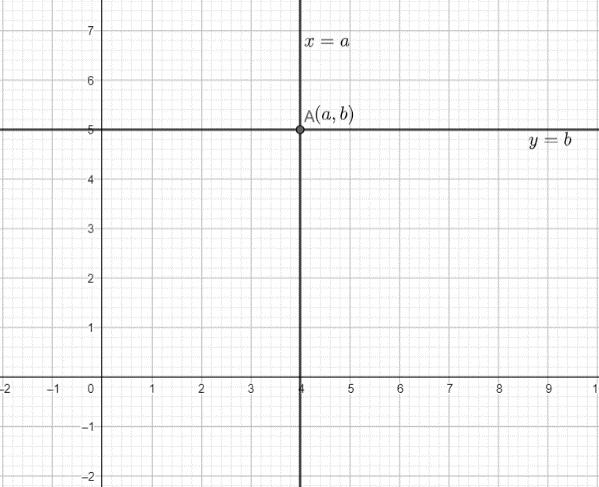Question
Question: The pair of equations \(x=a\) and \(y=b\) graphically represents lines which are: A.Parallel B.I...
The pair of equations x=a and y=b graphically represents lines which are:
A.Parallel
B.Intersecting at (b,a)
C.Coincident
D.Intersecting at (a,b)
Solution
Hint: The x coordinate of a point determines its distance from the y axis and the y coordinate of the point determines its distance from the x axis . A line parallel to the x axis is of the form y=c and a line parallel to the y axis is of the form x=c , where c is any constant.
Complete step-by-step answer:
Before plotting the points , we must know about the coordinate system.
The cartesian coordinate system is a system of identifying the location of a point with respect to two perpendicular lines , known as coordinate axes. The vertical axis is called the y axis and the horizontal axis is called the x axis. The point of intersection of these axes is called the origin and it is represented by the ordered pair (0,0). The distance of a point from the y axis is called the xcoordinate and the distance of the point from x axis is called the y coordinate of the point. The equation of a line passing through a point (x1,y1) is given as y−y1=m(x−x1) , where m is the slope of the line. Now, if the line is parallel to the x axis, then its slope is equal to zero . So, the equation of the line will be y−y1=0 . So, the y coordinate of any point on the line will be y1. Similarly, if the line is parallel to the y axis, then the slope of the line will be equal to infinity, and the equation of the line will be of the form x−x1=0 . So, the x coordinate of any point on the line will be x1.
Now, coming to the question, the pair of equations given to us are x=a and y=b. The equation x=a is of the form x−x1=0 , and hence, represents a line parallel to y axis at a distance of a units from it. Similarly, the equation y=b is of the form y−y1=0 , and hence, represents a line parallel to the x axis at a distance of b units from it. Hence, the two lines are perpendicular and therefore, will intersect at a point. Now, any point on the line x=a will have its x coordinate equal to a and any point on the line y=b will have its y coordinate equal to b . So, the coordinates of the point of intersection of the lines x=a and y=b will be (a,b) .
This can be represented graphically as:

So, the lines x=a and y=b are intersecting lines and they intersect at the point (a,b).
Hence, option D. is the correct option.
Note: Students get confused and write that the line x=a is parallel to the x axis , which is wrong. Such confusion should be avoided.
